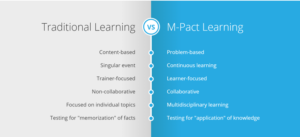In a previous article, I discussed how the coronavirus crisis is forcing organizations to rethink their approaches to training. In particular, moving to a virtual learning model. But you can’t simply convert existing classrooms into virtual instructor-led training (vILT). Instead, organizations need to transform their programs. Transformation means not only duplicating but improving the learning outcomes from your previous classroom program.
It Isn’t About the Technology or Techniques
In a response to the virtualization movement, organizations are focusing on two components:
- Virtual classroom technologies (WebEx, Skype, Zoom, etc.)
- Virtual facilitation techniques
Companies are beginning to review their technology options for use in the virtual classroom. What features and benefits do each component provide?
For example, some technologies allow for video, whiteboarding, document sharing, and virtual collaboration rooms. Although it is beneficial to have a set of virtual tools, the technology is secondary to how the training is designed. The same holds true to virtual facilitation techniques. The web is now full of “tips and tricks” for effective virtual facilitation. But these techniques assume you are still utilizing a lecture format and showing slides.
The foundation of effective learning is always instructional design. M-Pact Learning is a methodology that results in application of knowledge and skills and an associated competitive advantage. The graphic below shows the differences between traditional training and the M-Pact Learning methodology.

Blending for Effective Transformation
So how do we utilize M-Pact Learning to ensure effective virtual learning? Existing classroom materials need to be transformed using a blended learning approach. A blend that is specifically designed to be conducted virtually. There are three main components related to this blend.
Self-Paced Digital Modules
The first component is self-paced digital modules. Not the old “page-turners” where learners read, read more, then take a test; but rather an engaging, highly effective learning component. Self-paced digital modules should be short (micro-mods) and contain foundational knowledge. As an example, associates selling medical devices need a number of foundational elements including anatomy, physiology, disease states, and introduction to the product(s). Anatomy is especially tuned to self-paced learning. As an example, we created an interactive eye model that allowed users to understand refractive disorders like nearsightedness. Using a “slider”, the learners could see both the anatomic structures and the associated vision of patients with various disorders. The entire micro-mod took 7 minutes to complete.
Virtual Classroom
To start, virtual classroom training cannot be centered on a lecture format. Instead, the impetus for learning must be transferred to the learners. Continuing the example of training sales associates: For a virtual classroom session, break the participants into groups (Group A and Group B). Have each group prepare a presentation where they discuss your product against a competitor’s product. While Group A is presenting, have Group B evaluate that presentation. Provide Group B with an evaluation tool that identifies the key characteristics of a good presentation, including evaluation criteria. Then have the teams switch roles. Group B presents and Group A evaluates. Now, instead of lecturing, the facilitator can actually facilitate these exercises by providing additional insights, evaluations, and suggestions.
Performance Support Tools
The final component of the blended virtual learning solution involves the creation of performance support tools. Performance support tools help learners apply their knowledge in the field to more rapidly gain expertise. Continuing the example for training sales associates: Provide a tool that helps sales associates conduct virtual sales presentations. The tool could include a customer profiling element that allows the associate to create a profile by asking specific questions. The tool could also provide ways to overcome objections, etc.
Knowing that the coronavirus crisis will eventually pass, some organizations believe the movement towards virtual training will be temporary. Organizations that want to thrive and prosper in the future will not only transform their current training for virtual distribution, but will continue this approach to ensure they can withstand further adverse global events.
